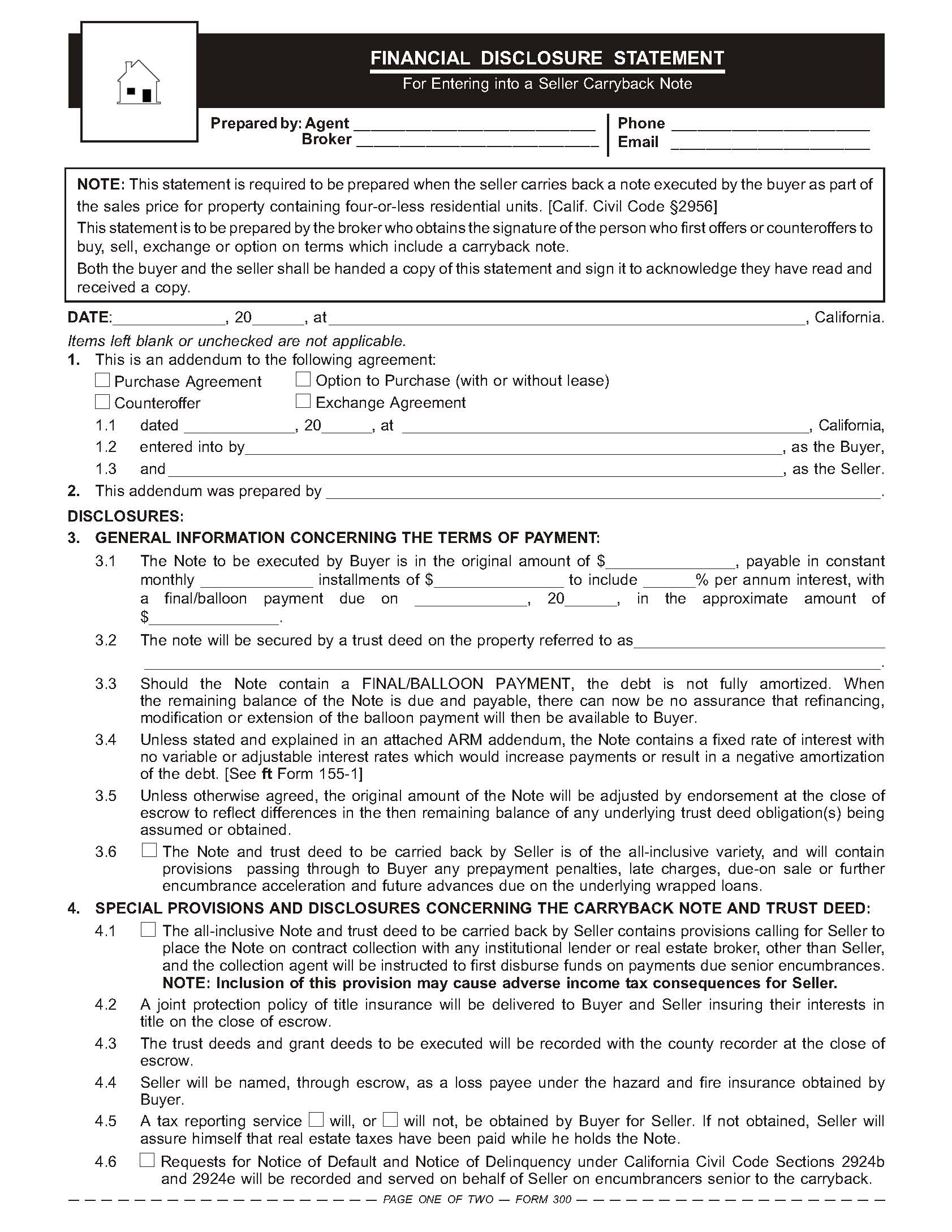Form-of-the-Week: Financial Disclosure Statement – For Entering into a Seller Carryback Note – Form 300
A buyer’s or seller’s agent negotiating a carryback offer has to disclose to both the buyer and seller the various financial and legal features which influence prudent sellers and buyers in a carryback transaction. For offers involving one-to-four residential units, the minimum carryback financing disclosures are mandated by statute, while disclosures for other types of property are imposed by case law.
The minimum carryback financing disclosures are collectively contained in a carryback disclosure statement. The carryback disclosure statement is attached to any purchase agreement containing provisions for a carryback note. [See first tuesday Form 150]
Though mandated on the sale of one-to-four residential units, a prudent seller’s agent will also use the disclosure statement in carryback transactions on all types of property as the method for making disclosures of material facts. [Calif. Civil Code §§2956 et seq.; see first tuesday Form 300]
Even the use of a masked security device, such as a land sales contract, lease-option or unexecuted purchase agreement with interim occupancy, requires a written carryback disclosure statement. [See first tuesday Form 300-1 and 300-2]
Written disclosure statements inform the buyer and seller about the extent of the risks presented by failing to use grant deeds, notes and trust deeds to evidence an installment sale when the buyer takes possession. [See first tuesday Form 300, 300-1 and 300-2]
On the sale of a one-to-four unit residential property, any credit extended by the seller to accommodate the buyer’s deferred payment of the purchase price requires a written carryback disclosure statement when the carryback arrangements include:
- interest or other finance charges;
- five or more installments running beyond one year;
- an installment land sales contract;
- a purchase lease-option or a lease-option sale;
- credit (note) to adjust equities in an exchange of properties; or
- an all-inclusive note and trust deed (AITD). [CC §2957]
Carryback financing disclosures are not mandated in carryback transactions creating straight notes which do not:
- bear interest; or
- include finance charges.
However, carryback disclosures need to be included as a matter of good brokerage practice since the risks and issues for the buyer and seller under a straight note are similar and the duty owed the client is the same.
Offer includes disclosures
The best policy for a buyer’s agent is to eliminate the need for further approval of the statutory carryback disclosures by preparing and attaching a carryback disclosure statement as an addendum to the purchase agreement. If the disclosure statement is not attached, the seller’s agent includes it as an addendum to a counteroffer to eliminate the disclosure contingency. [CC §2956]
If neither the buyer’s or seller’s agent prepares and includes the disclosure statement as an addendum to the offer or counteroffer, then, as a minimum requirement, the buyer’s agent is responsible for preparing the disclosure and obtaining both the buyer’s and seller’s signature prior to closing the carryback sale escrow. [CC §2959]
Under the statutory contingency for failure to timely make disclosures, if the buyer discovers a reasonable basis for disapproving the financing arrangements when the buyer receives the carryback disclosure statement after entering into the purchase agreement, the buyer may cancel the transaction and terminate their obligation to purchase the property. [CC §2959]
However, the buyer may not arbitrarily cancel the sale when they are presented with the carryback disclosure statement for their acknowledgment and approval during escrow. They need to have discovered a fact that is a justifiable cause for cancellation. Similar to the conduct of the seller, the buyer acts in good faith when cancelling by showing the carryback disclosures are inconsistent with their reasonable expectations when they entered into the purchase agreement. [CC §2961]
first tuesday’s Financial Disclosure Statement – For Entering into a Seller Carryback Note is a carryback financial statement used in seller carryback sales transactions for property with one-to-four residential units. The disclosure statement is prepared by either the buyer’s or seller’s agent and attached to the purchase agreement or counter offer as an addendum. [See first tuesday Form 300]
The information entered in the Financial Disclosure Statement is based on:
- the terms of the purchase offer;
- the title conditions;
- the activities to be undertaken in escrow; and
- the information obtained from the buyer.
Carryback disclosure provisions that make up the Financial Disclosure Statement include:
- information regarding the terms of the payment [See first tuesday Form 300 §3];
- disclosures concerning the carryback note and trust deed [See first tuesday Form 300 §4]; and
- information on encumbrances senior and prior to seller’s carryback trust deed and note. [See first tuesday Form 300 §5]
Besides confirming delivery of the carryback disclosure statement to both the buyer and seller, the buyer’s and seller’s agents involved need to be assured their respective clients understand and appreciate the risks and consequences which rise out of the financial and legal aspects of the carryback transaction.

















Are there ceiling restrictions on interest rates charged on a first note an deed of trust by an owner carry back?